| Botanical Name |
|
| Family |
Aloeaceae - The aloe family. |
| Pronunciation |
|
| Common Name(s) |
|
| Plant Group |
- Succulent A plant having fleshy stems or leaves often adapted to dry conditions.
|
| Plant Size |
- Very large
| Tree | Over 25m |
| Shrub | Over 4m |
| Perennial/ground cover | Over 1m |
| Bulb | Over 1.2m |
| Succulent | 1.5m to 2m |
|
| Position |
- Light or Dappled Shade Found below trees with sparse, open foliage. Ideal for the protection of herbaceous plants.
- Partial Shade The area is in shade for part of the day and in full sun for part of the day.
- Sun The area is in full sun for all or most of the day, all year round.
|
| General Information |
- Drought Tolerance: High The plant is well adapted to arid conditions; it can survive long periods of drought and high temperatures without extra water.
- Evergreen Plants that have leaves all year round.
- Frost: Half-hardy The plant is able to survive low temperatures and some frost but requires protection against severe frost.
- Roots Non-invasive Safe to plant near pools, paving, walls or buildings.
- Thorns / Spines / Prickles Thorn: A hard, woody, pointed branchlet.
Spine: A modified leaf forming a hard, sharp-pointed outgrowth.
Prickle: A small, sharp-pointed outgrowth growing from the bark of the plant.
- Water Wise Plant species originating from low rainfall regions that require less water to survive and thrive than other plant species.
|
| Specific Information |
Aloe liniata var. lineata is a medium sized single stemmed aloe reaching up to 2 meters in height after many decades. The leaves are bluish green with distinct reddish longitudinal lines on both surfaces and form a dense rosette. The margins are edged with firm reddish brown teeth. The stems of old plants become very thick and the upper parts are covered with the remains of old leaves.
Aloe lineata var. muirii has yellow-green leaves with very distinct red lines and larger teeth. It is differentiated from Aloe liniata var. lineata principally by its different flowering time, which is from June to November.
|
| Ad Break |
|
| Flowers |
| Description |
conical aloe flower on a long stem; up to 4 flower stems per rosette; buds covered by large bracts that hide the developing flower buds
|
| Season |
- Summer Plants will seldom bloom for the entire season as given in the list, but should flower during a period within these parameters.
|
| Colour |
|
| Growth Rate |
- Very Slow Specifying growth rate can be very misleading as there is considerable variation of growth rate depending on type and species of plant, available water, supplementary feeding, mulching and general care, as well as the plants suitability and adaptability to the garden environment.
|
| Plant Uses |
- Attracts bees, butterflies or other insects This plant attracts insects which can be food for birds or other creatures in your garden.
- Attracts Birds This plant will attract birds.
- Boundary A plant useful for planting around the edges of the property to form a green or colourful backdrop, an impenetrable hedge, to hide walls or create privacy.
- Container Trees, shrubs and ornamental species that can adapt to growing in a restricted environment.
- Filler Either a fast growing tree or shrub used temporarily to fill in an area while the permanent plants grow to a desired size, or a plant used to fill gaps in borders or beds.
- Rock Garden An area constructed of larger rocks, arranged naturally, to emphasise the use of stones as a main element. Generally plants used do not need a lot of care.
- Suitable for coastal gardens Plants adapted to dry, sandy soil, forceful wind, limited rainfall and intense sunlight.
- Wild Garden An indigenous garden planted for the benefit of wildlife and birds. Provides food, water, a variety of mini-biomes and no poisonous chemicals are used.
|
| Distribution and Habitat |
Aloe lineata var. lineata: from Riversdale in the Western Cape to Grahamstown in the Eastern Cape, in Albany thicket and dense, bushy vegetation, grassy fynbos and renosterveld
Aloe lineata var. muirii: in the Eastern Cape and the Little Karoo, from Ladismith and Riversdale to the Outeniqua Mountains in the Western Cape, on lower dry sandstone slopes at the interface between fynbos and renosterveld
|
| Planting Suggestions |
Aloe liniata is easy to cultivate but will need protection from severe frosts. Plant in well drained soil and water when dry. Poor drainage and over-watering can result in root rot and death.
|
| Medicinal Uses |
|
| Ad Break |
|


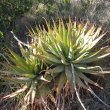
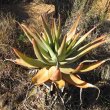
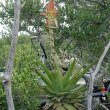
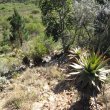

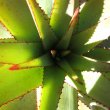


Discuss this plant
Share knowledge, ask a question or give an experience.